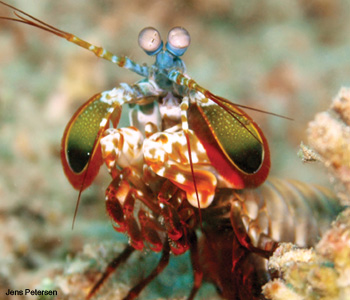Scatterings
Eyeing Shrimp Eyes for Manipulating Polarization
Researchers have found that a certain kind of shrimp not only sees polarized light, but has cells in its eyes that can manipulate it more efficiently than our best technology.
 Mantis shrimp can perceive light polarization because their eyes have cells that act as quarter-wave plates.
Mantis shrimp can perceive light polarization because their eyes have cells that act as quarter-wave plates.
Polarized-light detection has a range of scientific and technological uses— from the mundane (sunglasses) to the arcane (detecting naturally occurring masers in space). Now researchers have found that a certain kind of shrimp not only sees polarized light, but has cells in its eyes that can manipulate it more efficiently than our best technology.
…Log in or become a member to view the full text of this article.
This article may be available for purchase via the search at Optica Publishing Group.
Optica Members get the full text of Optics & Photonics News, plus a variety of other member benefits.
